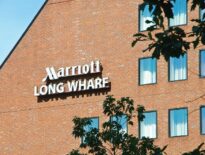
Noannet Group is developing Raffles Boston Back Bay Hotel and Residences with Saunders Hotel Group and Cain International. Image courtesy of The Architectural Team
It is no secret that the hotel industry is among the sectors hardest hit by the COVID-19-related shutdowns. Worldwide, occupancy levels and RevPAR dropped from some of their best–ever heights to near zero almost overnight, with many hotels in Boston and other major cities closing completely. With our two hotels presently under construction, Raffles Boston Back Bay Hotel & Residences and Cambria Somerville, every day brings new discussion as to how the current crisis will impact us.
We are fortunate that our projects closed on their financing in 2019 and are now in the early stages of construction – Cambria Somerville is slated to open late 2021 and Raffles Boston Back Bay Hotel & Residences in 2022. For most hotel projects in the development pipeline, however, financing prospects are now uncertain. While it may seem to all of us that the crisis has been going on forever and that we have been trapped at home with our kids for an eternity, in reality we are still in the first inning or two of figuring out what the long–term implications of this pandemic will be on the hotel world.
As such, lenders and investors are still working on trying to understand the short–, medium– and long-term impacts of the crisis on hotel markets, and it is expected that this evaluation process will continue for some time. During this time of uncertainty, what we can focus on is how to make hotels safer and healthier in a post-COVID world.
Operational Changes Underway
These changes have become critical in most hoteliers’ thinking both for the short term – when guests begin to return prior to a COVID-19 vaccine being found – and for the long term, to help “futureproof” against whatever comes next. Some changes already being implemented are operational, but other more extensive (and expensive) changes are also being investigated with respect to building systems.
From an operational standpoint, all major brands, as well as individual owners are rapidly working to establish new cleaning and sanitizing protocols to protect guest safety and make guests feel comfortable staying in hotels again.
Some may remember the old Saturday Night Live skit where Dan Ackroyd, spokesman for the American Motel Owners Association, leads a team of sanitizers in protective suits into a motel room where they blast all fixtures with torches and heat them to 1,500 degrees, ultimately leading to their wrapping the toilet seats with the iconic “SANITIZED for your protection” paper bands.
It turns out that skit, which seemed pretty absurd at the time, was not so far off. Ionization foggers are likely soon to become a standard part of room cleaning, coupled with cleaning spray products that dry in 10 minutes, and yes, leave guest rooms completely sanitized for our protection.
Physical Changes in the Offing
Physical changes to building systems are focused on two areas: air quality and touchable surfaces. While construction codes have evolved over the years, and air quality requirements have become more stringent; we are now looking at pushing even further than what is required by code. Discussions abound on increasing the size of air handling units, modifying system operations, and in certain circumstances, even increasing the size of ductwork ventilating buildings. For hotel areas with a higher percentage of recirculated air, increasing the type of in-system air filters and increased fan sizes are considerations.
Hotels, like all public buildings, are filled with surfaces touched by many people each day. A significant effort is underway to greatly reduce, if not eliminate, surfaces that need to be touched. Near-field communication systems, such as Apple Pay and those that allow a guest to enter a room using a smartphone eliminate the need for multiple people to touch credit cards or room keys, have already been expanding widely in usage. The pandemic is expected to greatly accelerate this trend. Similarly, fully touchless elevators where guests can get from the lobby to their rooms floor without pressing a button are receiving a lot of attention from developers and operators.

Jordan Warshaw
The hotel industry is a resilient one. As a rental business with a series of one–night leases, hotel cash flows are always among the quickest to fall when downturns hit, but over multiple financial cycles over many, many decades, the long-term RevPAR curve for hotels has always been a positive one.
Our current downturn clearly has hit the hotel industry in far worse a manner than any previous one, and travel patterns are likely to be impacted for quite some time, but by making operational and physical changes, we feel confident that the hotels of tomorrow will be well–equipped to make guests feel comfortable traveling again in the not-too-distant future.
Jordan Warshaw is president of the Noannet Group.




 |
| 

